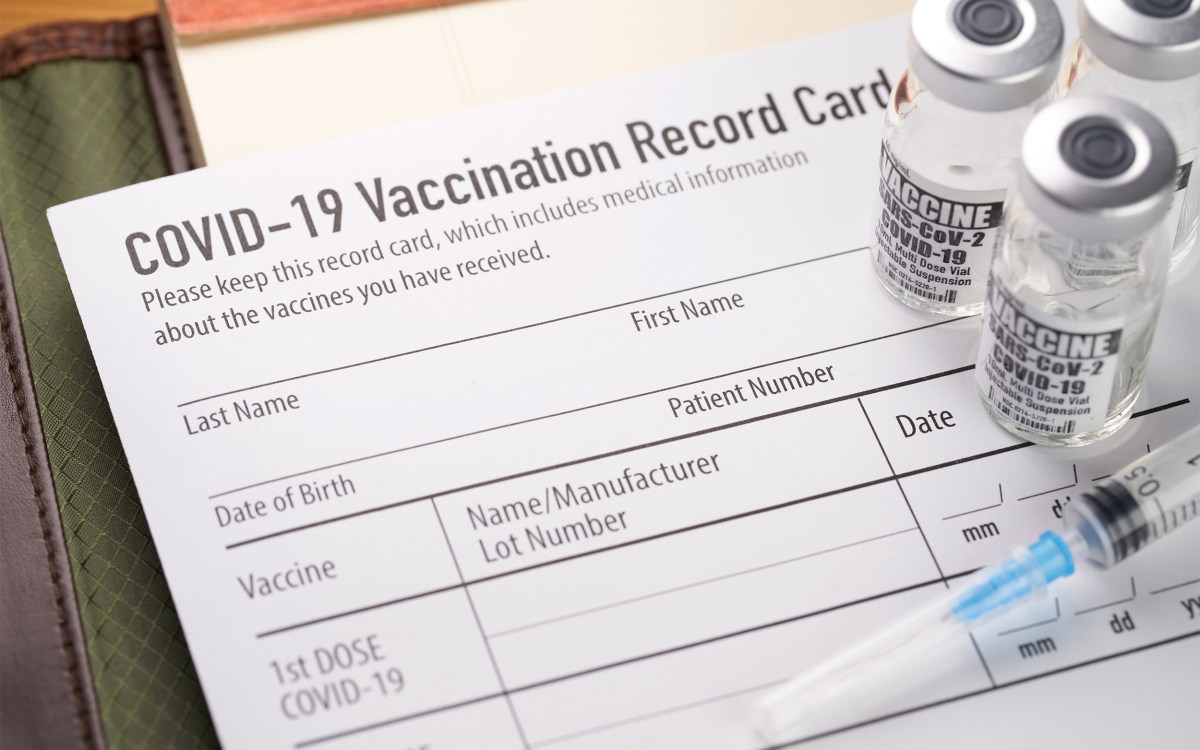
“As a primary care physician, people certainly come into my office with advertisements that they’ve printed off the internet or that they remember seeing during the football game the previous Sunday and say, ‘What about this drug?,” said Aaron Kesselheim.
Kris Snibbe/Harvard Staff Photographer
Those breezy TV drug ads? Take ’em with a grain of salt
HMS/Brigham study shows most advertised medicines little better than other treatment options
We’ve all seen the commercials. People relaxed, smiling, and having fun with friends and family despite having a horrible or uncomfortable — or at least chronic — condition. Their new lease on life comes courtesy of a drug. Then the fine print. Roll the list of potential side effects, some of which seem worse than the malady itself.
So why are the spots so popular with sponsors? Because they’re so effective — at least in terms of sales. In a recent issue of JAMA Network Open, Aaron Kesselheim and colleagues published the results of a study showing that some of the most heavily advertised drugs are largely no better at treating disease than other options. The Gazette spoke with Kesselheim, a professor of medicine at Harvard Medical School and director of the Program on Regulation, Therapeutics and Law at Brigham and Women’s Hospital, about the study.
Q&A
Aaron Kesselheim
GAZETTE: Most of us have seen direct-to-consumer commercials on TV, but could you briefly describe what they are?
KESSELHEIM: Direct-to-consumer advertising is the phrase usually applied to drug promotion directed to patients. That can include advertising on television, in magazines, and online.
GAZETTE: These are ads for prescription drugs? We’re not talking about over-the-counter medication that patients might be able to buy themselves at the local pharmacy?
KESSELHEIM: Direct-to-consumer advertising certainly can relate to over-the-counter drugs, but the most controversial DTCA involves products that require a prescription before a patient can access them.
GAZETTE: Was this once illegal?
KESSELHEIM: For many decades it was widely thought to be illegal under the federal Food, Drug and Cosmetic Act. That changed in the early 1980s, when the FDA declared DTCA to be permissible, and with input from the pharmaceutical industry and others went through a process of defining advertising rules. That led to an explosion in DTCA in magazines and other print media because it was largely thought that you couldn’t meet FDA guidelines relating to presenting both benefits and risks in a television spot. That changed in 1997, when the FDA described the circumstances under which drug manufacturers could engage in television advertising by providing a summary of the risks. After that, perhaps predictably, television advertising of prescription drugs exploded. That’s where we stand today.
GAZETTE: You examined the therapeutic value of these drugs. What was the rationale for your study and what did you find?
KESSELHEIM: We wanted to understand what clinical benefits the drugs subject to the most direct-to-consumer advertising had. We used independent assessments made of new drugs by health technology assessment organizations in Canada, France, and Germany. What we found was that only about 20 percent of drugs subjected to the most direct-to-consumer advertising in the U.S. were rated as having high added clinical benefits and the remainder were found to have low or no added clinical benefits over other treatment options.
GAZETTE: And you found a dollar figure for those with low added clinical value?
KESSELHEIM: The total advertising spending for all the drugs in our cohort was about $22 billion, and the drugs that had the lower added clinical benefits made up about $16 billion of that figure.
GAZETTE: Why would a company spend that money on a drug that doesn’t work as well as other drugs for the same condition?
KESSELHEIM: Drugs that have substantial benefits for patient care are more likely to sell themselves in that physicians will readily learn about them and be excited to use them. We saw this with the new class of hepatitis C drugs that emerged a few years ago. A drug that has low added benefits probably needs more advertising to encourage prescribing. Evidence from over the last 20 or 30 years shows that DTCA does drive prescribing practices and stimulates the prescribing of the drugs that are subject of the advertising. Pharmaceutical companies do direct-to-consumer advertising because they can and because they see a financial benefit.
GAZETTE: Obviously, much of this is consumers coming in and saying, “Doc, can you get me this?” But doctors watch TV, too, is that part of it as well?
KESSELHEIM: Direct-to-consumer advertising is really intended for consumers. As a primary care physician, people certainly come into my office with advertisements that they’ve printed off the internet or that they remember seeing during the football game the previous Sunday and say, “What about this drug?” Studies show that when patients come in and ask their physicians about particular drugs, they’re more likely to get prescriptions for those drugs. Doctors of course also watch TV, but the pharmaceutical industry spends much more money advertising its drugs directly to physicians, through visits to their offices, sponsorship of continuing medical education, support of professional society meetings, consultancies, and the like. Actually, the amount of money that pharmaceutical companies spend on advertising to physicians is far higher than the amount spent on direct-to-consumer advertising because physicians are the ones writing the prescriptions.
GAZETTE: And that’s occasionally been controversial?
KESSELHEIM: Sure, take for example the advertising around opioid medications, which included pharmaceutical companies making promotional music videos and lavishing gifts and other problematic promotional inducements onto doctors in ways that contributed to overuse of those drugs.
GAZETTE: Is there an argument that there is a clinical benefit from this advertising?
KESSELHEIM: People argue that direct-to-consumer advertising can encourage conversations between physicians and patients and can lead to people getting help for conditions, particularly ones with stigma attached to them, like mental illness. But I think that there are more effective ways to improve mental health care in America, such as through better education of physicians and more resources for services that aren’t associated with use of an expensive drug that may not have a lot of clinical value.
GAZETTE: What’s the ideal here? If doctors are already advertised to behind the scenes, would it be better if these just went away?
KESSELHEIM: Perhaps so. The U.S. and New Zealand are the only two industrialized countries that allow unfettered direct-to-consumer drug advertising. But, in the current judicial environment, due to cases from the Supreme Court and elsewhere interpreting the First Amendment’s protections around commercial speech, a total ban on direct-to-consumer advertising would be challenging to implement.
GAZETTE: Are there any changes to this practice on the horizon?
KESSELHEIM: There have been discussions over the last few years about making changes to rules around direct-to-consumer advertising. For example, some members of Congress have suggested pharmaceutical companies should not be allowed to get tax breaks for direct-to-consumer ads in the way that companies can use promotion as a business expense. The Trump administration proposed adding drug prices to direct-to-consumer ads, but that idea was challenged by the pharmaceutical industry and abandoned. I would expect to see similar minor changes in the future. It would also be good if the FDA, which has an office of prescription drug promotion that is supposed to monitor direct-to-consumer advertising, was given a fuller mandate — and more funding — to enforce its rules against particularly problematic advertisements.







